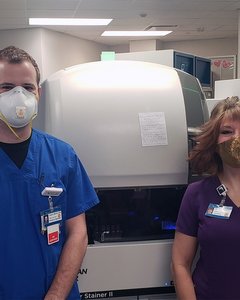Craig Minor has spent the better part of his nursing career caring for higher acuity patients. He knows that his patients often require multiple lab (venipunctures) draws a day and after several days in the hospital, phlebotomists run out of places to draw the labs. No one likes to get stuck by a needle that many times!
In Spring 2020, due to an increased demand for use, Sarah Bush Lincoln began using a new type of catheter that once it’s placed in the midline (upper arm), can stay in place for 28 days for IVs and other medications. “This is great,” Minor explained, “because at times, the medications can be so strong that they weaken the blood vessels in the hands and forearms. The vessels in the upper arm are stronger and can support its use.”
Bard, the catheter manufacturer, indicated that it could be used for lab draws as well, but it didn’t have any data to support the accuracy of a lab from this location. Minor, who is working on his doctorate degree in nursing, needed to know more to help his patients and improve their experiences.
Minor met with SBL Pathologist Robert Reuter, DO, to find out what he needed to do to use this catheter for lab draws. He met with the Internal Review Board and completed the paperwork to begin a research study. He then partnered with Medical Laboratory Specialist Amy Pfeiffer who assisted him by running labs concurrently on blood from the line and from a phlebotomist’s venipuncture to ensure the results were consistent. So throughout July and August, Minor approached his patients that he knew would receive several lab draws during their hospital stay.
“The needle is fairly large and scary looking and at first people were a little apprehensive about having it inserted, but when I explained that if they could sit still for 10 seconds, they would have one poke and it would be over, they agreed to try it. They were going to get poked anyway, so this seemed more appealing,” Minor explained. The catheter is inserted with guidance to ensure it is accurately placed in a large vein in the upper arm and terminates in the arm pit area.
In November, Minor finalized his study with the Internal Review Board and the Medical Ethics committee. Since September, he has done 100 guided IVs, and they have gone well. He is currently working on staff training so this practice is available 24/7, not just when he’s working.
Pfeiffer added, “This is good for our patients and good for us. Some of our patients are desperately ill, and they get multiple blood draws a day. The lab report is only as good as the specimen we collect. This study proves that using the mid-line catheter provides a good specimen."
This study is now the foundation of Minor’s doctoral work.

